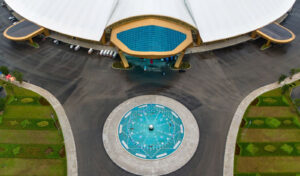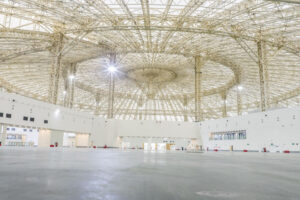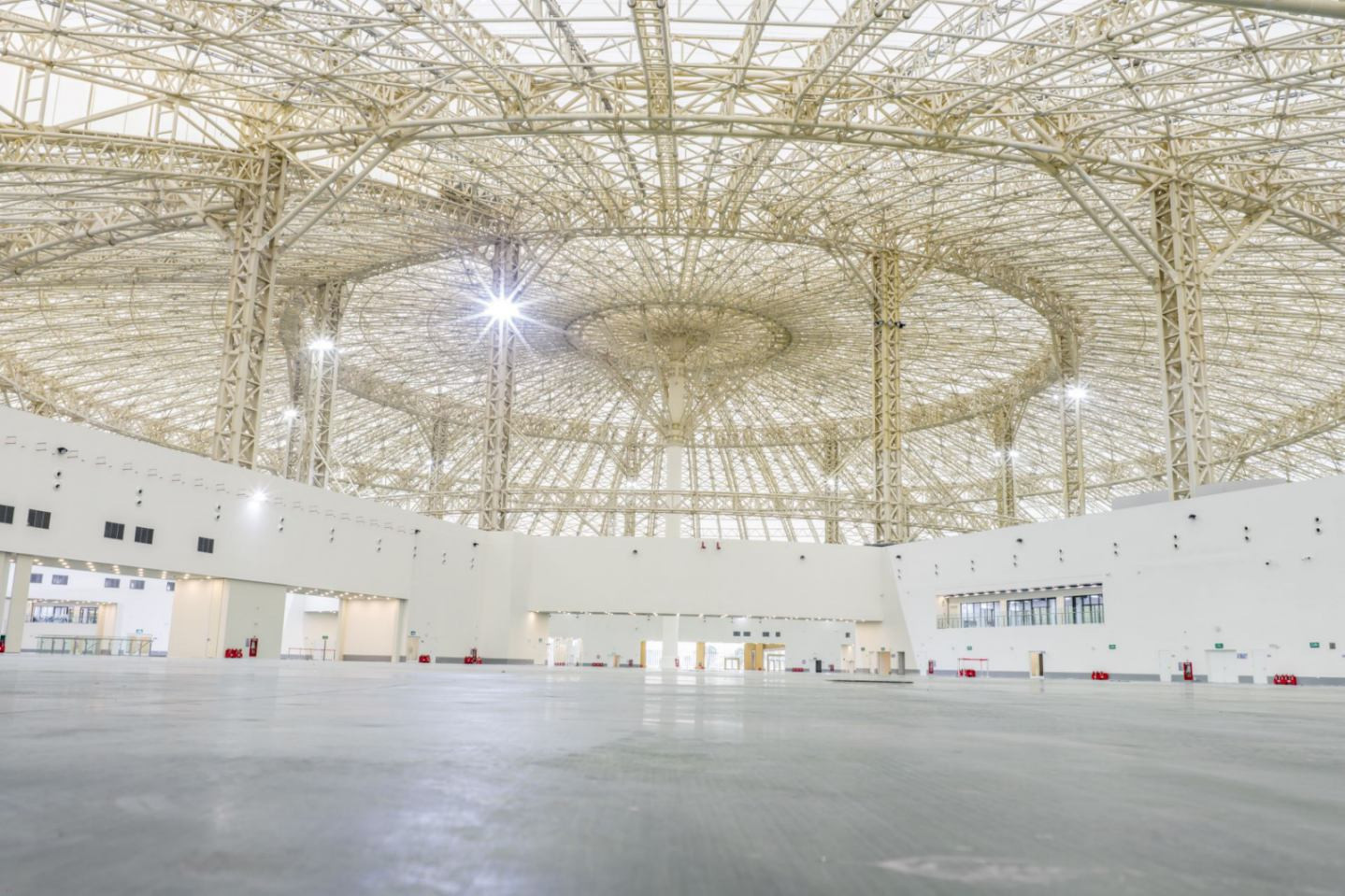 Vietnam builds world’s largest steel dome in record time
Vietnam builds world’s largest steel dome in record time
The Kim Quy Dome, a 24,000-ton steel marvel built in just five months, sets a world record and showcases Vietnamese engineering prowess.
Before the Kim Quy Dome became a world record, few imagined that a Vietnamese mechanical company could handle 24,000 tons of steel, with millimeter-level precision, in just a few months. Difficult challenges are often the true test of a Vietnamese business’s worth.
From the Prime Minister’s order
On a late October afternoon last year, Prime Minister Pham Minh Chinh, accompanied by Deputy Prime Minister Le Thanh Long, ministry leaders, and Hanoi city officials, visited the massive construction site of the National Exhibition and Convention Center in Dong Anh, Hanoi.
It was his second visit to the site in less than two months since the groundbreaking ceremony on August 30.
After touring what looked like a newly rising mega-urban zone – with cranes, trucks, floodlights, and thousands of busy workers – he declared the project “a testament to the capability and intellect of the Vietnamese people” and emphasized that “nothing is impossible” when they dare to think and act.
Referencing recent “feats” such as cutting the construction time for the 500kV transmission line from 3–4 years to just 6 months and the fast progress at Long Thanh Airport, the Prime Minister urged: “We must work quickly to put the facility into use and beautify Hanoi ahead of the 80th Independence anniversary. This must be a landmark project of historical significance.”
This directive became the driving force behind a series of milestones for the project, which will host the exhibition “80 Years of Independence – Freedom – Happiness” from August 28 to September 5.
The pressure on Vingroup – holding an 80% stake in the main investment consortium – was immense: a project originally scheduled for two years had to be finished in just 10 months.
Covering 90 hectares, this will be one of the world’s largest exhibition centers, an international destination for trade and cultural events.
The main building, with nine sections and a total floor area of over 130,000m², is inspired by the legendary Kim Quy (Golden Turtle) – a symbol of Vietnam’s resilience and longevity. Surrounding it are four outdoor exhibition parks totaling 20.6 hectares, two smaller indoor exhibition halls, a conference and wedding center, a Grade-A office tower, a Marriott 5-star hotel, and supporting facilities.
Nguyen Viet Quang, Vice Chairman of Vingroup, said: “This will be a modern project infused with Vietnamese identity, so that international guests will immediately recognize – this is Vietnam.”
Turning the tide under extreme pressure
Among the many components, the 24,000-ton steel dome of the Kim Quy Exhibition Hall stood out – both as the heart of the project and its greatest technical challenge.
Quang recalled: “Originally, we had two years for construction. Later, we had to restructure the entire schedule to finish in under 10 months.”
The dome allowed a margin of error of only a few millimeters, with no chance for correction – a daunting task. Few contractors dared to take it on, until a relatively new name emerged: Dai Dung.
Trinh Tien Dung, Chairman and CEO of Dai Dung, was invited to build the dome with just five months for completion.
He immediately recognized it as a “special case”: a turtle-shell-inspired spatial frame, made of ASTM steel, able to withstand typhoon-force winds of up to level 12 and earthquakes of magnitude 8, with a maximum deviation of 3mm.
For the construction engineering sector, this was the absolute limit. But for Dung, it was not just a business contract – it was a chance to prove Vietnamese capability.
More than 1,000 workers and engineers worked in three shifts around the clock. A 500-ton heavy-duty crane operated non-stop. Over 100,000 high-strength steel nodes and bolts were assembled under 3D laser scanning supervision. All steel was produced domestically.
Rain didn’t stop the work – welding continued under soaked tarpaulins. On windy days, crane operations were paused, but technical teams held urgent meetings onsite to adjust schedules. “Everyone knew we were making history,” Dung said.
The finished dome not only met exacting standards but also set a world record: the largest steel dome structure ever built, made entirely from Vietnamese-produced steel.
Experience from the ‘89th minute’ of the 2022 World Cup

This wasn’t Dai Dung’s first race against time. In 2017, when the Lusail Stadium in Qatar – venue for the 2022 FIFA World Cup final – hit a crisis after the Turkish contractor failed to deliver, Dai Dung was brought in at the “89th minute.”
The company passed rigorous factory, production, and construction capability checks, delivering 6,000 tons of steel for Lusail and all 28,000 tons for Ras Abu Aboud Stadium (Stadium 974) – a giant “Lego” structure with no welding, a tolerance of just 2mm.
Since then, Dai Dung has been listed among FIFA’s approved contractors and major global builders.
Unlike many firms that handle only one stage, Dai Dung controls the entire value chain: design, production, transportation, and assembly. With six factory complexes over nearly 100 hectares, an annual capacity of 300,000 tons, and a workforce of over 6,000 – nearly 1,000 of them engineers – the company is equipped for mega-projects worldwide.
Dung’s philosophy is simple: “To change the world, start by changing yourself.” His long-term strategy centers on investing in people, automation, and digital management.
From the Kim Quy Dome to global ambitions
In the upcoming “80 Years of Independence – Freedom – Happiness” exhibition, the dome will shelter displays of national achievements across industry, agriculture, science, technology, culture, and the arts. It will frame the stories Vietnam tells the world.
Dai Dung has also been a successful contractor for major domestic and international projects, from Tuy Hoa, Noi Bai, and Tan Son Nhat airport expansions to power plants in Indonesia and Vietnam, and manufacturing facilities for global corporations.
Dung aims to expand factory capacity to 120 hectares, produce over 500,000 tons of steel annually, and surpass 1 billion USD in revenue by 2030.
His management philosophy takes inspiration from the Vietnamese bamboo: deep roots, strong yet flexible stems. Over 30 years, Dai Dung has grown from a small mechanical workshop into a global player, contributing to iconic structures worldwide.
The 24,000-ton Kim Quy Dome – erected in just five months – stands in Dong Anh as proof that Vietnamese hands and minds can master the world’s most demanding projects.
From the Prime Minister to the project’s engineers, every visit to the site brought encouragement and satisfaction with the quality and progress.
When the exhibition opens at the end of August, sunlight streaming through the giant turtle-shell lattice will illuminate not just an architectural feat, but thousands of tireless hours of labor, the “nothing is impossible” spirit, and the skill of Vietnamese workers.
With its symbolic turtle shell – tied to the legend of the returned sword – the Kim Quy Dome speaks of durability, wisdom, and Vietnam’s cultural identity.
Difficult tasks are the true test of a company’s worth. Before this dome’s world record, few thought a domestic mechanical firm could handle such a challenge. Dai Dung did it – brilliantly.
Across Vietnam, many companies quietly build capacity, hone talent, and master technology, waiting for the moment to step into the light. When faced with seemingly impossible demands, they can break through and define themselves with world-class achievements.
It is in adversity that great enterprises are forged – and from them, Vietnam gains the foundation to stride confidently onto the global stage, not only with products, but with resilience and intellect.
Source: https://vietnamnet.vn/en/vietnam-builds-world-s-largest-steel-dome-in-record-time-2431550.html


